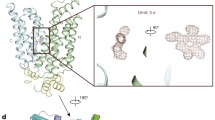Summary
The kinetics of the initial phases of d-glucose binding to the glucose transport protein (GLUT1) of the human red cell can be followed by stopped-flow measurements of the time course of tryptophan (trp) fluorescence enhancement. A number of control experiments have shown that the trp fluorescence kinetics are the result of conformational changes in GLUT1. One shows that nontransportable l-glucose has no kinetic response, in contrast to d-glucose kinetics. Other controls show that d-glucose binding is inhibited by cytochalasin B and by extracellular d-maltose. A typical time course for a transportable sugar, such as d-glucose, consists of a zero-time displacement, too fast for us to measure, followed by three rapid reactions whose exponential time courses have rate constants of0.5–100 sec+−1 at 20°C. It is suggested that the zero-time displacement represents the initial bimolecular ligand/GLUT1 association. Exponential 1 appears to be located at, or near, the external membrane face where it is involved in discriminating among the sugars. Exponential 3 is apparently controlled by events at the cytosolic face. Trp kinetics distinguish the K d of the epimer, d-galactose, from the K dfor d-glucose, with results in agreement with determinations by other methods. Trp kinetics distinguish between the binding of the α- and β-d-glucose anomers. The exponential 1 activation energy of the β-anomer, 13.6 ± 1.4 kcal mol+−1, is less than that of α-d-glucose, 18.4 ± 0.8 kcal mol+−1, and the two Arrhenius lines cross at ≈23.5°C. The temperature dependence of the kinetic response following α-d-glucose binding illustrates the interplay among the exponentials and the increasing dominance of exponential 2 as the temperature increases from 22.3 to 36.6°C. The existence of these interrelations means that previously acceptable approximations in simplified reaction schemes for sugar transport will now have to be justified on a point-to-point basis.
Similar content being viewed by others
References
Appleman, J.R., Lienhard, G.E. 1985. Rapid kinetics of the glucose transporter from human erythrocytes. J. Biol. Chem. 260:4575–4578
Appleman, J.R., Lienhard, G.E. 1989. Kinetics of the purified glucose transporter. Direct measurement of the rates of interconversion of transporter conformers. Biochemistry 28:8221–8227
Barnett, J.E.G., Holman, G.D., Munday, K.A. 1973. Structural requirements for binding to the sugar-transport system of the human erythrocyte. Biochem. J. 131:211–221
Carruthers, A. 1986. Anomalous asymmetric kinetics of human red cell hexose transfer: Role of cytosolic adenosine 5′-triphosphate. Biochemistry 25:3592–3602.
Carruthers, A. 1990. Facilitated diffusion of glucose. Physiol. Rev. 70:1135–1176
Carruthers, A., Melchior, D.L. 1985. Transport of αand β-dglucose by the intact human red cell. Biochemistry 24:4244–4250
Challiss, J.R.A., Taylor, L.P., Holman, G.D. 1980. Sugar transport asymmetry in human erythrocytes—the effect of bulk hemoglobin removal and the addition of methylxanthines. Biochim. Biophys. Acta 602:155–166
Faust, R.G. 1960. Monosaccharide penetration into human red blood cells by an altered diffusion mechanism. J. Cell. Comp. Physiol. 56:103–121
Fujii, H., Miwa, I., Okuda, J., Tamura, A., Fujii, T. 1986. Glucose transport into human erythrocytes treated with phospholipase A2 or C. Biochim. Biophys. Acta 883:77–82
Ginsburg, H., Stein, W.D. 1975. Zero-trans and inflnite-cis uptake of galactose in human erythrocytes. Biochim. Biophys. Acta 382:353–368
Gorga, F.R., Lienhard, G.E. 1982. Changes in the intrinsic fluorescence of the human erythrocyte monosaccharide transporter upon ligand binding. Biochemistry 21:1905–1908
Helgerson, A.L., Carruthers, A. 1987. Equilibrium ligand binding to the human erythrocyte sugar transporter. J. Biol. Chem. 262:5464–5475
Janoshazi, A., Kifor, G., Solomon, A.K. 1991. Conformational changes in human red cell membrane proteins induced by sugar binding. J. Membrane Biol. 123:191–207
Kahlenberg, A., Dolansky, D. 1972. Structural requirements of d-glucose for its binding to isolated human erythrocyte membranes. Can. J. Biochem. 50:638–643
Krupka, R.M. 1971. Evidence for a carrier conformational change associated with sugar transport in erythrocytes. Biochemistry 10:1143–1148
Krupka, R.M., Déves, R. 1981. An experimental test for cyclic versus linear transport models. J. Biol. Chem. 256:5410–5416
Lacko, L., Burger, M. 1962. Interaction of some disaccharides with the carrier system for aldoses in erythrocytes. Biochem. J. 83:622–625
Lew, V.L. 1971. On the ATP dependence of the Ca+2-induced increase in K+ permeability observed in human red cells. Biochim. Biophys. Acta 233:827–830
Low, P.S., Allen, D.P., Zioncheck, T.F., Chari, P., Willardson, B.M., Geahlen, R.L., Harrison, M.L. 1987. Tyrosine phosphorylation of band 3 inhibits peripheral protein binding. J. Biol. Chem. 262:4592–4596
Lowe, A.G., Walmsley, A.R. 1986. The kinetics of glucose transport in human red blood cells. Biochim. Biophys. Acta 857:146–154
Lowe, A.G., Walmsley, A.R. 1989. The kinetics and thermodynamics of glucose transport in human erythrocytes. In: Red Blood Cell Membranes. P. Agre, J.C. Parker, editors, pp. 597–633, Marcel Dekker, New York
Lux, S.E., John, K.M., Kopito, R.R., Lodish, H.F. 1989. Cloning and characterization of band 3, the human erythrocyte anion-exchange protein (AE1). Proc. Nat. Acad. Sci. USA 86:9089–9093
Miwa, I., Fujii, H., Okuda, J. 1988. Asymmetric transport of dglucose anomers across the human erythrocyte membrane. Biochem. Int. 16:111–117
Mueckler, M., Caruso, C., Baldwin, S.A., Panico, M., Blench, I., Morris, H.R., Allard, W.J., Lienhard, G.E., Lodish, H.F. 1985. Sequence and structure of a human glucose transporter. Science 229:941–945
Pawagi, A.B., Deber, C.M. 1990. Ligand-dependent quenching of tryptophan fluorescence in human erythrocyte hexose transport protein. Biochemistry 29:950–955
Pigman, W. 1957. The Carbohydrates. Chemistry, Biochemistry and Physiology, pp. 49–53. Academic, New York
Wang, J.-F., Falke, J.J., Chan, S.I. 1986. A proton NMR study of the mechanism of the erythrocyte glucose transporter. Proc. Nat. Acad. Sci. USA 83:3277–3281
Widdas, W.F. 1988. Old and new concepts of the membrane transport for glucose in cells. Biochim. Biophys. Acta 947:385–404
Author information
Authors and Affiliations
Additional information
We should like to express our thanks to Michael R. Toon for his important contributions. This work was supported in part by a grant-in-aid from the American Heart Association, by the Squibb Institute for Medical Research and by The Council for Tobacco Research.
Rights and permissions
About this article
Cite this article
Janoshazi, A., Solomon, A.K. Initial steps of αand β-d-glucose binding to intact red cell membrane. J. Membarin Biol. 132, 167–178 (1993). https://doi.org/10.1007/BF00239006
Received:
Revised:
Issue Date:
DOI: https://doi.org/10.1007/BF00239006




